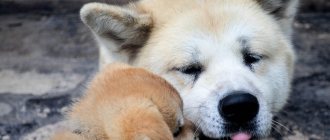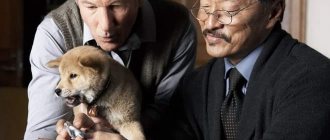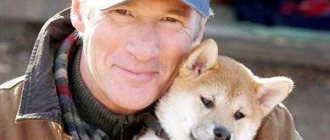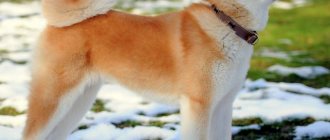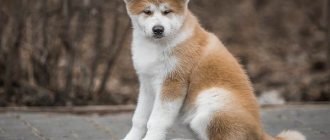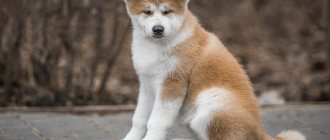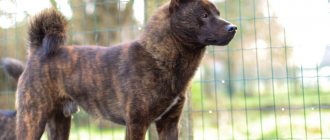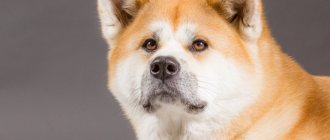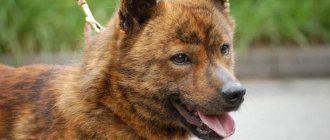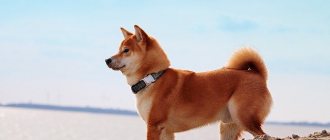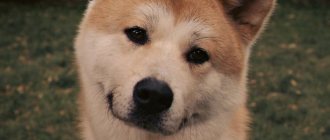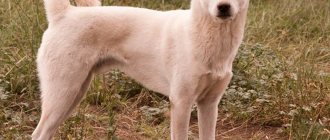Breeding large commercial huskies ( Akita Inu and continental prototype, American BYA) is work that requires great responsibility, a serious material base and a huge reserve of time/effort. Breeding is not a commercial activity—the breeder’s goal is to improve the population and distribute the breed in a high-quality manner.
Mating of an American (and native) Akita Inu : a series of tasks and hassles, visiting single-breed exhibitions, contacts with nurseries, searching for an ideal pair, organizing the process (veterinary medicine, territory for crossing, documentation), selling puppies, help/support for new owners.
Choice of male
The main rule of “selecting a gentleman”: all minor defects in the exterior and extremes of the character of a toothy young lady must be smoothed out (balanced) by the appearance and condition of the dog.
A good selection criterion is the results of the applicant’s exhibition activity: an international-class court clearly determines the purity of blood, compliance with standard standards, and personal qualifications.
Features of care
The coat is combed twice a week; during the shedding period, it is recommended to use a special brush that removes dead hair or a furminator..
The inside of the ears is cleaned with damp cotton pads, and the ear canal is cleaned with chopsticks.
The claws either grind down on their own during walks, or they need to be shortened as needed with pruning shears for large breeds.
To clean teeth, it is recommended to give your dog special toys or treats to chew on.
These dogs are washed 2-3 times a year.
Pre-fuss
The first step in preparing your dog for breeding is a visit to a good veterinarian. Examination, tests to identify diseases and contraindications. Two months before the intended mating, the animal should be vaccinated. Before meeting the selected gentleman partner, you need to check whether the Akita Inu girl has sexual desire.
Estrus in the island (and American ) Akita Inu occurs in four stages:
- The estrous cycle starts from seven to ten days. The dog's loop becomes erect and secretes blood. The bitch is not yet ready for intercourse, but nervous behavior is clearly present;
- Estrus - ovulation occurs, the secretion is almost transparent or disappears. The bitch is ready for mating: conception is most likely during these five to twelve days;
- Metestrus—the next eight to ten days of the cycle: discharge fades away;
- Anestrus is a period of rest: the ovaries go into “sleepy mode”.
The first heat in an Akita Inu most often occurs at the age of one year, lasting on average 25 days. The most favorable period for conception: the tenth day of the cycle.
The main thing is not to rush, it is advisable to wait until the female is at least two years old: very young Akita Inu may refuse to mate.
Distinctive features
Breed standards:
- The head is positioned in proportion to the body. Wide forehead without wrinkles, with a clearly defined transition from forehead to muzzle. Nose with a large black lobe. It is not desirable, but it is acceptable that white dogs have a lighter and more diffuse color. The muzzle is wide, tapering towards the nose.
- The eyes are small brown, with slightly upturned outer corners, giving the impression of a triangular eye shape. Moderately wide apart. It is believed that the closer to black the shade of the eyes, the better.
- The ears are in the middle, thick, triangular in shape with semicircular tips. Standing, leaning forward. Moderately wide apart.
- bite , powerful lips and close-fitting lips.
- They have a muscular and thick neck without a dewlap, located in proportion to the head.
- The paws are powerful and well developed, thick and round in shape. The movements in the gait are elastic.
- The body is balanced, the physique is strong. The height at the withers relative to the length of the body is 10:11, and the female looks more elongated than the males. Has a straight back, deep chest and a well-shaped belly.
- The coat has guard hairs - hard and straight, as well as a soft, thick undercoat. Guard hairs grow in two layers: the outer one is long, the inner one is shorter. Together with the undercoat, three layers of wool are obtained. The function of the layers is as follows: the undercoat warms the dog, the water-repellent outer hair protects it from getting wet by snow or water. Therefore, Akitas tolerate cold and rain well. The hair on the “pants” and shoulder blades is longer than on other parts of the body. The hair on the tail is the longest.
- They have a thick, high-set tail, curled over the back .
Favorable time
To determine the optimal time for mating, it is best to contact a veterinary clinic: laboratory tests and consultation with an experienced veterinarian will greatly help in solving this difficult task.
You can take advantage of centuries of experience gained by nurseries and kennels. Experienced breeders recommend the following methodology:
- We take a sample of secreted mucus: apply a glass slide to the loop;
- distribute the test analysis over the surface.
- if the drying test generates a crystalline structure, the “wedding” can begin. If no crystals form, time has passed or the dog is not yet ready for mating.
Content
According to clause 3 of the Breeding Regulations of the RKF, the following conditions must be met for ADMISSION OF DOGS INTO PEDIGREE BREEDING:
— 3.1. All of the following requirements for admitting a dog to breeding in this section must be met before mating.
— 3.2. Dogs that have certificates of origin/pedigrees (extracts from the VERK) issued by the RKF or one of the organizations listed in clause 1.4 are allowed for breeding. of this Regulation.
— 3.3. The owner of a dog leased on the territory of the Russian Federation from 01/01/2020 or later, in order to allow it for breeding, must have a lease agreement concluded in writing, with the obligatory indication of: - the lease term; — rental conditions; — postal and email addresses of the landlord and tenant; — contact numbers of the landlord and tenant;
— 3.4. The lease agreement (form No. 12) must be certified by a notary or a CA of which the lessor is a member. If the lessor is a citizen of another country, the agreement is completed in one of the official languages of the FCI (English, French, German, Spanish) and certified by a notary or NGO of the country in which the lessor resides.
— 3.5. If the bitch is in common ownership, then the joint ownership (co-ownership) agreement, concluded on or after 01/01/2020, must contain the following conditions: - which of the parties to the agreement will be considered the breeder; — the name of which kennel will be used when registering litters obtained from this bitch; - which of the parties to the co-ownership agreement has the right to sign the mating act.
— 3.6. The co-ownership agreement (form No. 13) must be certified by a notary or a CA of which one of the co-owners is a member. If the co-owner is a citizen of another country, the agreement is completed in one of the official languages of the FCI (English, French, German, Spanish).
— 3.7. If the dog is in common ownership, the agreement of joint ownership (co-ownership), concluded on 01/01/2020 or later, must contain conditions regarding the signature of which of the co-owners is required to formalize the mating act. The co-ownership agreement must be certified by a notary or CA. If the co-owner is a citizen of another country, the agreement is completed in one of the official languages of the FCI (English, French, German, Spanish).
— 3.8. Dogs imported to the Russian Federation (females are mandatory, males are preferable) must be registered with the Verkhovna Rada of the Russian Federation in order to receive admission to breeding.
— 3.9. Admission to breeding of male dogs living and registered outside the Russian Federation is carried out according to the rules of the country of their permanent residence/registration.
— 3.10. For dogs belonging to the VP, instead of diplomas/certificates for working qualities, a certificate of passing departmental tests is sufficient.
— 3.11. The RKF has two types of admission to breeding: primary (temporary) and lifelong.
3.11.1. Primary (temporary) admission to pedigree breeding of dogs born on 01/01/2020 and later is given if they have one mark for exterior not lower than “very good”, received at any certificated exhibition of the RKF / FCI, or primary admission at the RKF breeding show.
3.11.2. Primary admission gives the right to use females once and males three times.
3.11.3. Lifetime admission to pedigree breeding of dogs born on December 31, 2019 and earlier is given if they have one rating of at least “very good” received at any RKF / FCI certified exhibition, or admission received at the age of over 15 months at the RKF breeding show (“Recommended for breeding”, “Admitted for breeding” or “Conditionally admitted for breeding”).
3.11.4. Lifetime admission to pedigree breeding of dogs born on 01/01/2020 and later is given: - in the presence of two marks for exterior not lower than “very good”, received from two different judges at any RKF / FCI certificate exhibitions; in this case, one score must be obtained after the dog reaches 15 months of age in the “intermediate”, “open”, “working” classes; - in the presence of two admission assessments from the RKF breeding shows from two different judges (“Recommended for breeding”, “Admitted for breeding”, “Conditionally admitted for breeding”); however, one conclusion must be obtained over the age of 15 months.
— 3.12. All dogs born starting from 01/01/2020 and belonging to breeds that are marked in the nomenclature (Appendix 1) as giants (G), large (K) and medium ©, except for dogs of hunting breeds, are also required to successfully pass dog behavior testing (T) or successful completion of tests/competitions in one of the following disciplines: UGS, OKD, obedience, BH/VT, UPr 1–3. It is desirable to have a certificate of HD (grades A, B, C) and ED (grades 0, 1, 2) research results.
— 3.13. All dogs born starting from 01/01/2020 and belonging to breeds that are marked in the nomenclature (Appendix No. 1) as small (M), except for dogs of hunting breeds, for admission to breeding require a detailed description of behavior in the exhibition description, or passing a breeding review with a detailed description of behavior or successful completion of dog behavior testing (T) or successful completion of tests / competitions in one of the following disciplines: UGS, OKD. It is desirable to have a certificate of research results PL in the sum of two knees no more than 2 (possible variations: PL 0/0, 0/1, 1/0, 1/1, 0/2, 2/0).
— 3.14. Dogs of hunting breeds born starting from 01/01/2020 (regardless of size) are required to successfully pass tests in one of the profile species or successfully pass dog behavior testing (T) in order to be admitted to breeding.
— 3.15. Additional requirements for admission to breeding for dogs permanently residing in the territory of the Russian Federation and belonging to breeds of groups I and II with mandatory working tests are listed in Appendix No. 2 to these Regulations.
— 3.16. The list of mandatory health tests, which are a condition for admission to selective breeding for specific breeds, is contained in Appendix No. 2 to these Regulations.
— 3.17. The first mating of a bitch admitted to participate in breeding can be carried out provided that the bitch reaches the following age at the time of mating:
at least 18 months - for females of small and medium breeds*;
at least 20 months – for females of large breeds*;
at least 22 months - for giant breed bitches*. *
For the division of rocks into small, medium, large and giant, see Appendix No. 1
— 3.18. During the entire breeding period of a bitch, no more than six litters can be obtained from her (optimally three litters).
— 3.19. The interval between birth dates of litters should be at least 300 days (recommended interval is 365 days).
During the entire period of breeding use of a bitch, two litters in a row are allowed once, without missing a heat; in this case, the interval between litters must be at least 6 months, and the next litter from the same bitch can be obtained no earlier than 18 months after the birth of the puppies of the previous litter.
— 3.20. A male dog can participate in breeding from the moment he is admitted to breeding use and without limiting the maximum permissible age.
— 3.21. Private owners make decisions on the selection of breeding pairs for their dogs independently.
— 3.22. In exceptional cases, on the basis of a justified application submitted by the breeder before mating, the RKF PC may admit dogs rated “good” for breeding.
— 3.23. The decision on the advisability of mating dogs that are related by blood (I–II: father–daughter, II–I; mother–son; II–II: brother–sister, half-sibs) is taken under the responsibility of the KO, PE or VP carrying out breeding activities in the RKF system in accordance with clauses 2.1 and 2.2 of these Regulations.
— 3.24. The following cannot be used in breeding:
* dogs not allowed for breeding;
* females who have not reached the minimum age for admission to breeding;
* bitches who have reached the age of 8 years or more at the time of mating;
* dogs that have a certificate of origin with o or “Without the right of breeding use in Russia”;
* dogs that received a “Disqualification” rating (for aggression - three “Disqualification” ratings) at certified RKF exhibitions, if this rating was not protested and removed in the prescribed manner;
* dogs that received the rating “Not allowed for breeding” at the RKF breeding show;
* dogs owned by right of ownership, common ownership or lease to persons disqualified in the RKF / FCI system from participation in breeding work.
clause 4. BREEDER
— 4.1. The breeder is considered to be the owner of the breeding bitch, to whom it belongs by right of ownership, common ownership or lease during the period from the moment the bitch is mated until the moment the puppies born by the bitch are transferred to new owners.
— 4.2. In the case of purchasing or leasing a mated bitch, the breeder is considered to be the person in whose legal possession the bitch is at the time of birth of the puppies. Legal ownership implies that the owner has a title document/agreement concluded in writing, in compliance with the conditions provided for in these Regulations.
— 4.3. The breeder is obliged to strictly comply with all the requirements of the current legislation of the Russian Federation, these Regulations and bears full responsibility for the results of his activities.
clause 5. MATING AND REGISTRATION OF THE MATING ACT
— 5.1. Mating of a pair selected for breeding is carried out in the presence of the dog owners or persons authorized by the owners in accordance with the requirements of the current legislation (based on a power of attorney, mandate agreement or other document).
— 5.2. Immediately before mating (both initial and control), dog owners or their representatives are required to identify the dogs using available means of identification (stamps and/or microchips). Dogs are mated only after their identification.
Requirements for the “family bed”
An important factor in the successful and effective mating of an Akita Inu is the place of the “wedding,” the mating territory. The “marriage bed” should be prepared in advance, agreed upon, and approved.
A visit from the “bride” to the “toothed groom” is considered more practical and appropriate: a male dog who finds himself in someone else’s deployment can “give slack,” show nervousness, and sabotage contact.
Akita Inu are large, energetic animals: a small room will cramp commercial huskies and create difficulties and discomfort. For mating large Akitas (especially the American type), it is better to select a fenced area, a large enclosure that provides the couple with sufficient space.
If the love games of the shaggy “groom” and “bride” take place in a spacious room, the slippery floor should be covered with carpet. In the cold season, it is better to sprinkle the icy ground with sand.
Experienced dog handlers advise choosing secluded places where the couple being brought together will not be frightened by strangers or distracted by passing dogs.
Subtleties of training
Only an experienced person who has previously worked with service dogs can raise an animal at home. The breed is characterized by pride and stubbornness. Dogs will not do something if they are bored and don't like it. You shouldn't use force. If you are rude, the dog will stop respecting you. Only the owner should train the dog. Responsibilities include establishing rapport and arousing the animal's interest in activities. Stages:
- At 5 months, the puppy should clearly know its name, its place in the house and the basic rules of behavior. Attempts to bite the hand are unacceptable.
- From 6-8 months, training requires a serious and regular approach.
- Training should be varied. If the dog is interested, he will learn a lot.
- Is it possible to fire a 61 year old man?
- Professional appearance for women over 50
- 6 Surprising Symptoms of Menopause
Knitting nuances
- when visiting a shaggy gentleman, the female should be given time to calm down, look around, get used to a foreign place (smells, objects);
- The standard procedure for starting mating is the exchange of certificates declaring the health of participants;
- the owner of the bitch is responsible for the correctness of the chosen day: if the date is selected incorrectly, the male will not show interest, and the “toothy young lady” herself will show aggression towards the gentleman.
- it is necessary to hold the bitch when trying to wriggle out of the “lock”;
- Control mating is traditionally carried out every other day.
Feed
The basis of the diet of these dogs in their homeland, Japan, is rice, fish and seafood, seaweed, and vegetables. Purebred Akitas are adapted specifically to this diet. They very often have an allergic reaction to chicken, beef, fatty dairy products, wheat, corn and oatmeal. To feed puppies of the Japanese dog Hachiko, you should stock up and always have boiled sea fish, low-fat cottage cheese, veal, fruits and vegetables at the ready. It is difficult for an adult dog to choose suitable dry food, since the soy contained in ready-made mixtures is poorly digestible by Akitas. It is optimal to stick to food that has only one source of protein - fish or duck. The protein proportion should be a maximum of 26%.
What are the symptoms of pregnancy
Until the end of the first month after mating an Akita (and the American version of BJA), it is difficult to confirm pregnancy . One can only operate with assumptions and forecasts based on indirect symptoms (decreased appetite, lethargy) and external manifestations (swelling of the vagina, rounding of the abdomen).
Only by the forty-fifth day do the nipples turn pink and swell, the fur around them begins to bristle: this is the activation of the maternal instinct, preparation for feeding the puppies.
Experienced veterinarians recommend an ultrasound procedure in the fourth or fifth week after mating.
Breed characteristics
| Short description | |
| Origin: | Japan |
| Conditions of detention: | Apartment, private house, street |
| Purpose: | Companion, guard, service dog |
| Color: | Pure white, brindle, red-fawn and sesame (red-fawn hair with a black tip). All colors except white have “urajiro” - lightened hair on the sides of the muzzle, on the cheekbones, lower jaw, neck and chest, on the body, tail and on the inside of the paws |
| Wool length: | Long, has guard hair and undercoat |
| Adult dog size: | The height of females is 57-65 cm, males 66-71 cm. Weight of females is 31-44 kg, males 41-51 kg. |
| Average life expectancy: | 13 years |
| Walk: | Every day for two hours, twice |
| Physical activity needs: | Average physical activity needs (active games while walking) |
| Fédération Cynologique Internationale (FIC) classification: | Group 5: Spitz and primitive breeds; Section 5: Asian Spitz and related breeds. |
| Puppy price: | A show-class puppy, from champion parents, with good prospects at exhibitions - from 50-70 thousand rubles. A pet-class puppy (marriage based on breed characteristics) can be bought for 15-20 thousand rubles. A standard puppy without defects and without unique parents is sold for 30-40 thousand rubles. |
Birth difficulties
The American and native Akita give birth 60-62 days after crossing. If labor pains do not begin by the sixty-third day, you should urgently call a veterinarian and obstetrician.
The American Akita has a litter of five to eight puppies . Island huskies are less fertile: the Japanese Akita gives birth to no more than five shaggy babies.
American Akita puppies – how to choose
If you are planning to buy a dog, then contact a breeder you trust. Be sure to find out how many years it has been on the market, study reviews on the Internet. Features of choosing a puppy:
- First, find out information about the parents. Both appearance and behavior matter, because the puppy will inherit all this. If the parent dogs are aggressive, this is considered a fault and can be passed on to the baby.
- Check with the breeder. An experienced dog breeder will tell you which puppy will be good as a hunter, and which one is better to take for exhibitions or a family.
- Don't buy a dog that is too small. Until 9 months they are not assigned exhibition classes. Only the dog's prospects will be indicated, and then only approximately.
- Do not adopt a puppy with red, watery eyes, a swollen belly, or twisted knees or elbows. A dog that is too thin will not do either. The puppy's coat should be soft to the touch and shiny. A healthy dog should be active, because lethargy is one of the first manifestations of many diseases.
Features of education
From the first minutes of the puppy's appearance in the house, the owner must establish contact with him, otherwise the dog will grow uncontrollable and ignore any requests and orders. You need to behave strictly with your dog, but do not cross the line and do not resort to violence. You should treat the puppy with restraint and patience, then he will begin to respect his owner and will stand up for defense if necessary.
Knitting officialdom and the price of the issue
The owners of the couple being brought together draw up a mating agreement in advance. The document stipulates: the price of all procedures, prescribes conditions excluding further disputes. The tradition is this: the owner of the male can take payment with a “maintenance” puppy, or receive it in money. The cost of breeding an Akita Inu is calculated from the planned sale price of the baby and depends on the status of the nursery and the regalia of the parent couple.
Often the contract includes additional financial burden for the services of a veterinarian and a mating instructor. Service prices vary depending on the region: in Moscow, an expert breeder costs up to five thousand rubles.
Feeding choose a method
The life expectancy of the American Akita directly depends on the animal’s proper nutrition, physical activity and care.
There are two types of food:
- Natural: cooking your own food, ready-made thermally processed food from natural products;
- Ready-made food: dry production.
- Advantages of natural feeding: you know what your dog’s food consists of, you select all the products yourself.
- Pros of dry food: no need to prepare, does not require additional calculation, fully balanced, specially selected for age, activity and breed characteristics, hypoallergenic.
We recommend that you pay attention to feeding dry, ready-made premium food that can provide the correct diet and the need for all vitamins, minerals and nutrients.
If you want to feed the animal yourself, then the calculation of the daily diet will look like this: 30 grams of protein per 1 kg of an adult animal. Everything else in a ratio of 20/10% comes from vegetables, herbs, fruits and cereals.
Products for the diet:
- Meat is lean, boneless, raw: chicken, beef, duck;
- Sea fish, boiled and boned;
- Cartilage and ligaments (tendons) in dry and fresh form;
- By-products: liver, tripe, neck, kidneys, lung, heart;
- Porridge: buckwheat, oatmeal, rice;
- Vegetable fats;
- Vegetables: zucchini, eggplant, pumpkin, cucumber, carrots, bell peppers; broccoli, cauliflower, white cabbage, a little tomato;
- Seasonal fruits: exclude citrus fruits, grapes and plums.
- Bone flour;
- Mineral supplements;
- Vitamins.
- Fresh greens.
You should not alternate different foods; if the animal has food, then feed it only, if it is natural food, then only that. But you can switch to one and the other type gradually, excluding alternation. And you should not mix natural products with food.
Adults eat 2 times a day, puppies 3-5 times a day in small portions; with age, the number of feedings decreases and the portion increases.
It is prohibited to give:
- Pasta;
- Potato;
- Chocolate, sweet pastries, any sugar;
- Do not use in cooking: salt and any other spices and seasonings.
- Bones: tubular;
- Scraps and table scraps;
- Convenience foods and human food.
